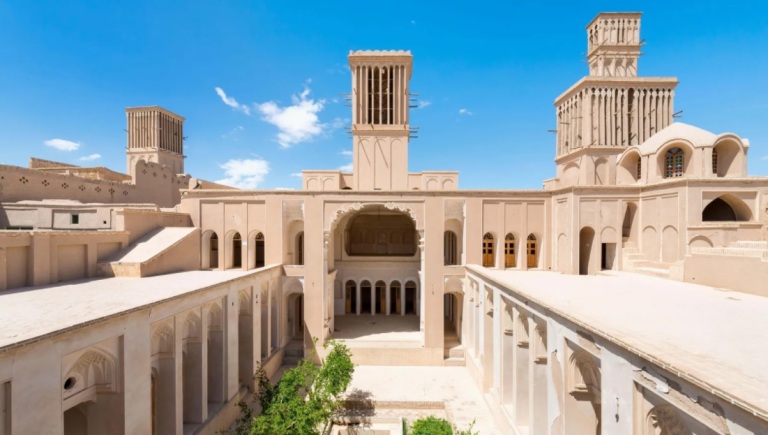
The city of Yazd in the desert of central Iran has long been a focal point for creative ingenuity. COURTESY
From Ancient Egypt to the Persian Empire, an ingenious method of catching the breeze kept people cool for millennia. In the search for emissions-free cooling, the “wind catcher” could once again come to our aid
The city of Yazd in the desert of central Iran has long been a focal point for creative ingenuity. Yazd is home to a system of ancient engineering marvels that include an underground refrigeration structure called yakhchāl, an underground irrigation system called qanats, and even a network of couriers called pirradaziš that predate postal services in the US by more than 2,000 years. Among Yazd's ancient technologies is the wind catcher, or bâdgir in Persian. These remarkable structures are a common sight soaring above the rooftops of Yazd. They are often rectangular towers, but they also appear in circular, square, octagonal and other ornate shapes. Yazd is said to have the most wind catchers in the world, though they may have originated in Ancient Egypt. In Yazd, the wind catcher soon proved indispensable, making this part of the hot and arid Iranian Plateau livable. Though many of the city's wind catchers have fallen out of use, the structures are now drawing academics, architects and engineers back to the desert city to see what role they could play in keeping us cool in a rapidly heating world. As a wind catcher requires no electricity to power it, it is both a cost-efficient and green form of cooling. With conventional mechanical air conditioning already accounting for a fifth of total electricity consumption globally, ancient alternatives like the wind catcher are becoming an increasingly appealing option. There are two main forces that drive the air through and down into the structures: the incoming wind and the change in buoyancy of air depending on temperature – with warmer air tending to rise above cooler, denser air. First, as air is caught by the opening of a wind catcher, it is funneled down to the dwelling below, depositing any sand or debris at the foot of the tower. Then the air flows throughout the interior of the building, sometimes over subterranean pools of water for further cooling. Eventually, warmed air will rise and leave the building through another tower or opening, aided by the pressure within the building.
The shape of the tower, alongside factors like the layout of the house, the direction the tower is facing, how many openings it has, its configuration of fixed internal blades, canals and height are all finely tuned to improve the tower's ability to draw wind down into the dwellings below. Using the wind to cool buildings has a history stretching back almost as long as people have lived in hot desert environments. Some of the earliest wind-catching technology comes from Egypt 3,300 years ago, according to researchers Chris Soelberg and Julie Rich of Weber State University in Utah. Here, buildings had thick walls, few windows facing the Sun, openings to take in air on the side of prevailing winds and an exit vent on the other side – known in Arabic as malqaf architecture. Though some argue that the birthplace of the wind catcher was Iran itself. Wherever it was first invented, wind catchers have since become widespread across the Middle East and North Africa. Variations of Iran's wind catchers can be found in the barjeels of Qatar and Bahrain, the malqaf of Egypt, the mungh of Pakistan, and many other places, notes Fatemeh Jomehzadeh of the University of Technology Malaysia and colleagues. The Persian civilisation is widely considered to have added structural variations to allow for better cooling – such as combining it with its existing irrigation system to help to cool the air down before releasing it throughout the home. In Yazd's hot, dry climate, these structures proved remarkably popular, until the city became a hotspot of soaring ornate towers seeking the desert wind. The historical city of Yazd was recognised as a Unesco World Heritage site in 2017, in part for its proliferation of wind catchers.
As well as performing the functional purpose of cooling homes, the towers also had a strong cultural significance. In Yazd, the wind catchers are as much a part of the skyline as the Zoroastrian Fire Temple and Tower of Silence. Among them is the wind catcher at the Dowlatabad Abad Gardens, said to be the tallest in the world at 33m (108ft) and one of the few wind catchers still in operation. Housed in an octagonal building, it overlooks a fountain stretching past rows of pine trees. The emissions-free cooling efficacies of such wind catchers make some researchers argue that they are due a revival. Parham Kheirkhah Sangdeh has extensively studied the scientific application and surrounding culture of wind catchers in contemporary architecture at Ilam University in Tehran, Iran. He says inconveniences like pests entering the chutes and the gathering of dust and desert debris have meant many have turned away from traditional wind catchers. In their place are mechanical cooling systems, such as conventional air-conditioning units. Often, those options are powered by fossil fuels and use refrigerants that act as powerful greenhouse gases if released into the atmosphere.






0 Comments